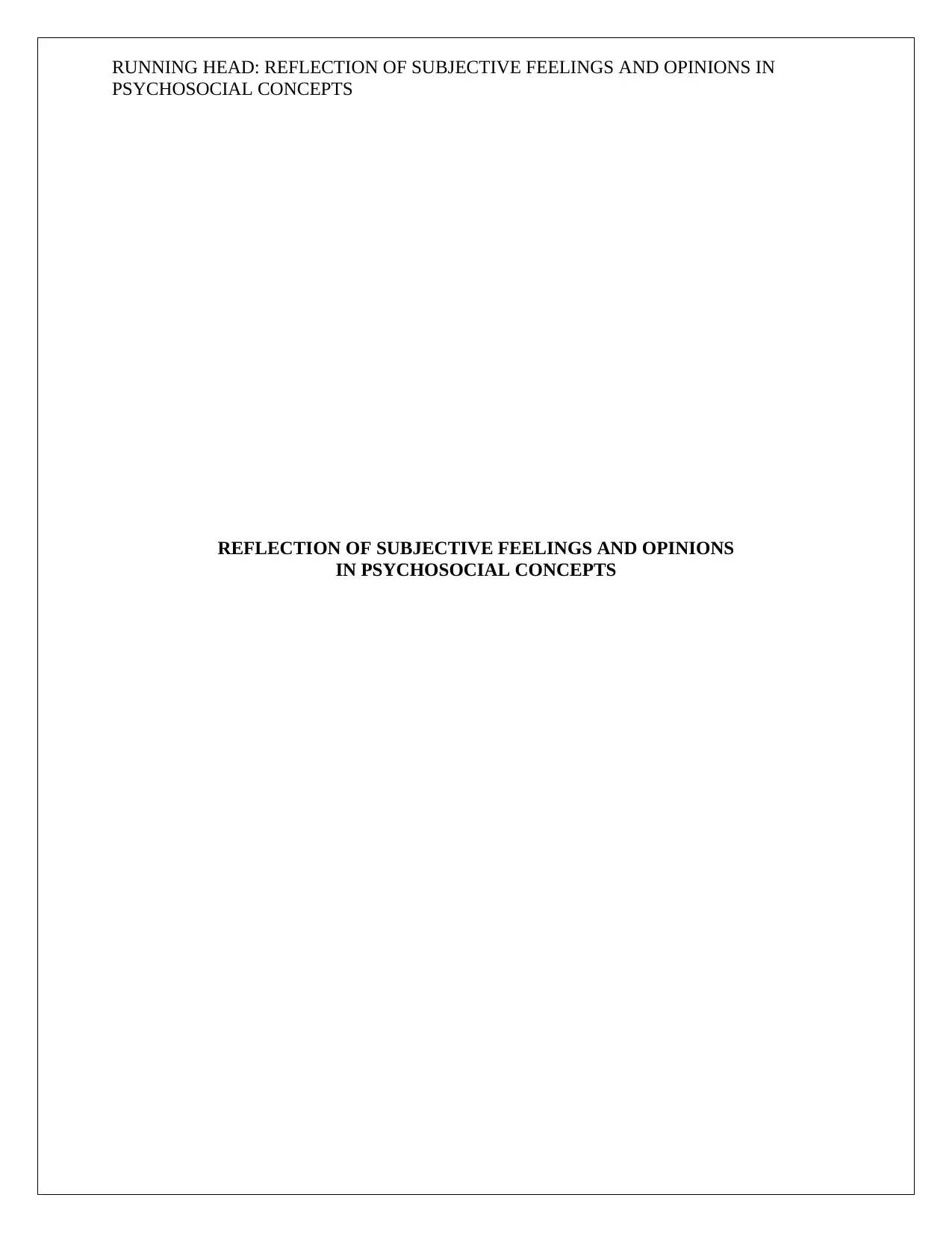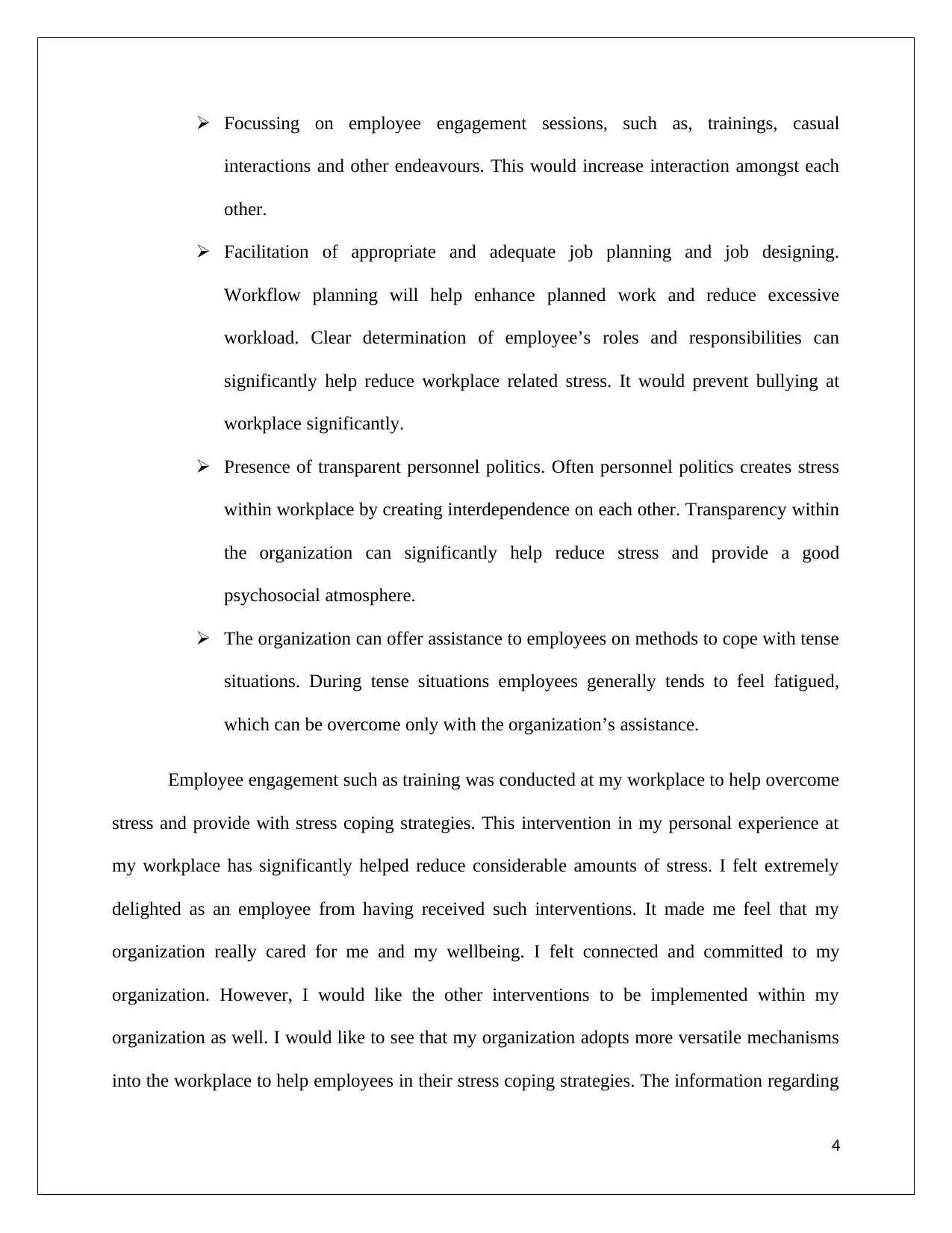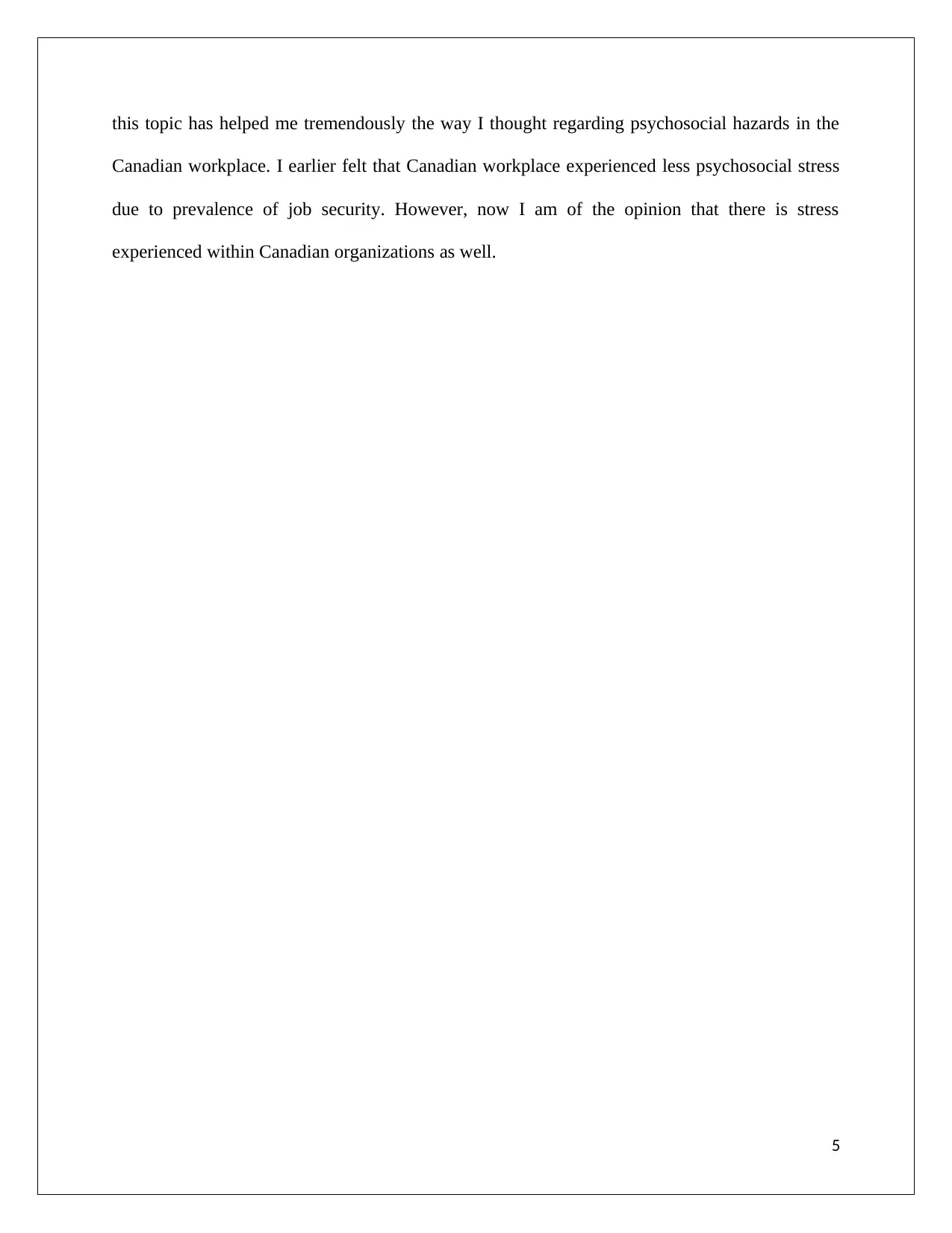HRES 2303 Occupational Health and Safety
VerifiedAdded on 2021/09/09
|6
|1051
|92
AI Summary
Contribute Materials
Your contribution can guide someone’s learning journey. Share your
documents today.

RUNNING HEAD: REFLECTION OF SUBJECTIVE FEELINGS AND OPINIONS IN
PSYCHOSOCIAL CONCEPTS
REFLECTION OF SUBJECTIVE FEELINGS AND OPINIONS
IN PSYCHOSOCIAL CONCEPTS
PSYCHOSOCIAL CONCEPTS
REFLECTION OF SUBJECTIVE FEELINGS AND OPINIONS
IN PSYCHOSOCIAL CONCEPTS
Secure Best Marks with AI Grader
Need help grading? Try our AI Grader for instant feedback on your assignments.

Introduction
Management of Occupational Health and Safety is an integral concept across
organizations (Pinto, Nunes & Ribeiro, 2011). It includes psychosocial concepts that provide
safety to employees within the organization. The current scope of analysis includes a reflective
analysis includes my perspective as an Occupational Health and Safety Specialist. While
working within an organization, one staff experienced significant fatigue and burn out from
stress. Due to the prevalent of immense stress within my organization such that it is able to
compete in the industry. This incident increased my awareness regarding the importance of
occupational health and safety in workplace. Business strategy of the organization included, to
be able to serve its customers well. My organization’s vision was to cater to customer’s
satisfaction. Mission is to provide a great work environment such that employees are able to live
with dignity and respect. The purpose of the organization is to provide a great organization
culture for its employees.
Psychosocial Hazard
Psychosocial hazard in the workplace impacts the psychological well-being of workers,
hampering their capability to work. Within my organization, there is a present tremendous
amount of workplace stress that hampers the environment (Makin & Winder, 2008). Stress is a
negative factor within workplace that deters productivity and creates a negative atmosphere.
Increased levels of stress increases fatigue and has tremendous psychosocial effects. In presence
of stress employees are unable to focus on their current job role, take decision related to
communication. One feels mentally pressurised from such levels of stress which also hampers
creativity to a great extent. Employees are unable to concentrate in their current job roles and
they suffer from fatigue, communication problems amongst others. Once employees are not able
2
Management of Occupational Health and Safety is an integral concept across
organizations (Pinto, Nunes & Ribeiro, 2011). It includes psychosocial concepts that provide
safety to employees within the organization. The current scope of analysis includes a reflective
analysis includes my perspective as an Occupational Health and Safety Specialist. While
working within an organization, one staff experienced significant fatigue and burn out from
stress. Due to the prevalent of immense stress within my organization such that it is able to
compete in the industry. This incident increased my awareness regarding the importance of
occupational health and safety in workplace. Business strategy of the organization included, to
be able to serve its customers well. My organization’s vision was to cater to customer’s
satisfaction. Mission is to provide a great work environment such that employees are able to live
with dignity and respect. The purpose of the organization is to provide a great organization
culture for its employees.
Psychosocial Hazard
Psychosocial hazard in the workplace impacts the psychological well-being of workers,
hampering their capability to work. Within my organization, there is a present tremendous
amount of workplace stress that hampers the environment (Makin & Winder, 2008). Stress is a
negative factor within workplace that deters productivity and creates a negative atmosphere.
Increased levels of stress increases fatigue and has tremendous psychosocial effects. In presence
of stress employees are unable to focus on their current job role, take decision related to
communication. One feels mentally pressurised from such levels of stress which also hampers
creativity to a great extent. Employees are unable to concentrate in their current job roles and
they suffer from fatigue, communication problems amongst others. Once employees are not able
2

to deliver their productivity, it creates a challenge relative to interpersonal relationships at
workplace. Interpersonal relationships amongst employees are crucial to be maintained at
workplace as it helps developing a cordial work culture. Presence of a good work culture and
organization culture helps in attainment of organization’s end goals (Zanko & Dawson, 2012).
Psychosocial factors are directly connected to ability of employees to maintain appropriate
relationship with other employees at workplace. Exposure to such hazards can deter employees
from the workplace and create negative impression, leading to absenteeism and even turnover.
Outcomes in the workplace
The organization can easily diagnose stress being experienced by five measurable ways
such as increase of bullying, poor interpersonal relationships, increased occupational violence,
poor communication amongst employees and increased rate of fatigue at workplace (Kelloway,
2013).
These outcomes I have experienced myself and my colleagues also suffers the
same.
I have frequently got into conflict with my colleagues due to workplace stress.
Apart from this symptom displayed by me, I have also found that I am unable to
maintain proper interpersonal relationship with anyone at workplace.
Interventions in the workplace
Stress has tremendous potentiality to hamper workplace culture, hence employer needs to
adopt appropriate steps such that they are able to manage or reduce stress. The ways in which an
employer could potentially reduce stress within an organization includes;
3
workplace. Interpersonal relationships amongst employees are crucial to be maintained at
workplace as it helps developing a cordial work culture. Presence of a good work culture and
organization culture helps in attainment of organization’s end goals (Zanko & Dawson, 2012).
Psychosocial factors are directly connected to ability of employees to maintain appropriate
relationship with other employees at workplace. Exposure to such hazards can deter employees
from the workplace and create negative impression, leading to absenteeism and even turnover.
Outcomes in the workplace
The organization can easily diagnose stress being experienced by five measurable ways
such as increase of bullying, poor interpersonal relationships, increased occupational violence,
poor communication amongst employees and increased rate of fatigue at workplace (Kelloway,
2013).
These outcomes I have experienced myself and my colleagues also suffers the
same.
I have frequently got into conflict with my colleagues due to workplace stress.
Apart from this symptom displayed by me, I have also found that I am unable to
maintain proper interpersonal relationship with anyone at workplace.
Interventions in the workplace
Stress has tremendous potentiality to hamper workplace culture, hence employer needs to
adopt appropriate steps such that they are able to manage or reduce stress. The ways in which an
employer could potentially reduce stress within an organization includes;
3

Focussing on employee engagement sessions, such as, trainings, casual
interactions and other endeavours. This would increase interaction amongst each
other.
Facilitation of appropriate and adequate job planning and job designing.
Workflow planning will help enhance planned work and reduce excessive
workload. Clear determination of employee’s roles and responsibilities can
significantly help reduce workplace related stress. It would prevent bullying at
workplace significantly.
Presence of transparent personnel politics. Often personnel politics creates stress
within workplace by creating interdependence on each other. Transparency within
the organization can significantly help reduce stress and provide a good
psychosocial atmosphere.
The organization can offer assistance to employees on methods to cope with tense
situations. During tense situations employees generally tends to feel fatigued,
which can be overcome only with the organization’s assistance.
Employee engagement such as training was conducted at my workplace to help overcome
stress and provide with stress coping strategies. This intervention in my personal experience at
my workplace has significantly helped reduce considerable amounts of stress. I felt extremely
delighted as an employee from having received such interventions. It made me feel that my
organization really cared for me and my wellbeing. I felt connected and committed to my
organization. However, I would like the other interventions to be implemented within my
organization as well. I would like to see that my organization adopts more versatile mechanisms
into the workplace to help employees in their stress coping strategies. The information regarding
4
interactions and other endeavours. This would increase interaction amongst each
other.
Facilitation of appropriate and adequate job planning and job designing.
Workflow planning will help enhance planned work and reduce excessive
workload. Clear determination of employee’s roles and responsibilities can
significantly help reduce workplace related stress. It would prevent bullying at
workplace significantly.
Presence of transparent personnel politics. Often personnel politics creates stress
within workplace by creating interdependence on each other. Transparency within
the organization can significantly help reduce stress and provide a good
psychosocial atmosphere.
The organization can offer assistance to employees on methods to cope with tense
situations. During tense situations employees generally tends to feel fatigued,
which can be overcome only with the organization’s assistance.
Employee engagement such as training was conducted at my workplace to help overcome
stress and provide with stress coping strategies. This intervention in my personal experience at
my workplace has significantly helped reduce considerable amounts of stress. I felt extremely
delighted as an employee from having received such interventions. It made me feel that my
organization really cared for me and my wellbeing. I felt connected and committed to my
organization. However, I would like the other interventions to be implemented within my
organization as well. I would like to see that my organization adopts more versatile mechanisms
into the workplace to help employees in their stress coping strategies. The information regarding
4
Paraphrase This Document
Need a fresh take? Get an instant paraphrase of this document with our AI Paraphraser

this topic has helped me tremendously the way I thought regarding psychosocial hazards in the
Canadian workplace. I earlier felt that Canadian workplace experienced less psychosocial stress
due to prevalence of job security. However, now I am of the opinion that there is stress
experienced within Canadian organizations as well.
5
Canadian workplace. I earlier felt that Canadian workplace experienced less psychosocial stress
due to prevalence of job security. However, now I am of the opinion that there is stress
experienced within Canadian organizations as well.
5

References
Kelloway, F. (2013). Management of Occupational Health and Safety. 7th Edition
Makin, A. M., & Winder, C. (2008). A new conceptual framework to improve the application of
occupational health and safety management systems. Safety Science, 46(6), 935-948.
Accessed on https://www.sciencedirect.com/science/article/pii/S092575350700166X
Pinto, A., Nunes, I. L., & Ribeiro, R. A. (2011). Occupational risk assessment in construction
industry–Overview and reflection. Safety science, 49(5), 616-624. Accessed on
https://www.sciencedirect.com/science/article/pii/S0925753511000051
Zanko, M., & Dawson, P. (2012). Occupational health and safety management in organizations:
A review. International Journal of Management Reviews, 14(3), 328-344. Accessed on
https://onlinelibrary.wiley.com/doi/abs/10.1111/j.1468-2370.2011.00319.x
6
Kelloway, F. (2013). Management of Occupational Health and Safety. 7th Edition
Makin, A. M., & Winder, C. (2008). A new conceptual framework to improve the application of
occupational health and safety management systems. Safety Science, 46(6), 935-948.
Accessed on https://www.sciencedirect.com/science/article/pii/S092575350700166X
Pinto, A., Nunes, I. L., & Ribeiro, R. A. (2011). Occupational risk assessment in construction
industry–Overview and reflection. Safety science, 49(5), 616-624. Accessed on
https://www.sciencedirect.com/science/article/pii/S0925753511000051
Zanko, M., & Dawson, P. (2012). Occupational health and safety management in organizations:
A review. International Journal of Management Reviews, 14(3), 328-344. Accessed on
https://onlinelibrary.wiley.com/doi/abs/10.1111/j.1468-2370.2011.00319.x
6
1 out of 6
![[object Object]](/_next/static/media/star-bottom.7253800d.svg)




